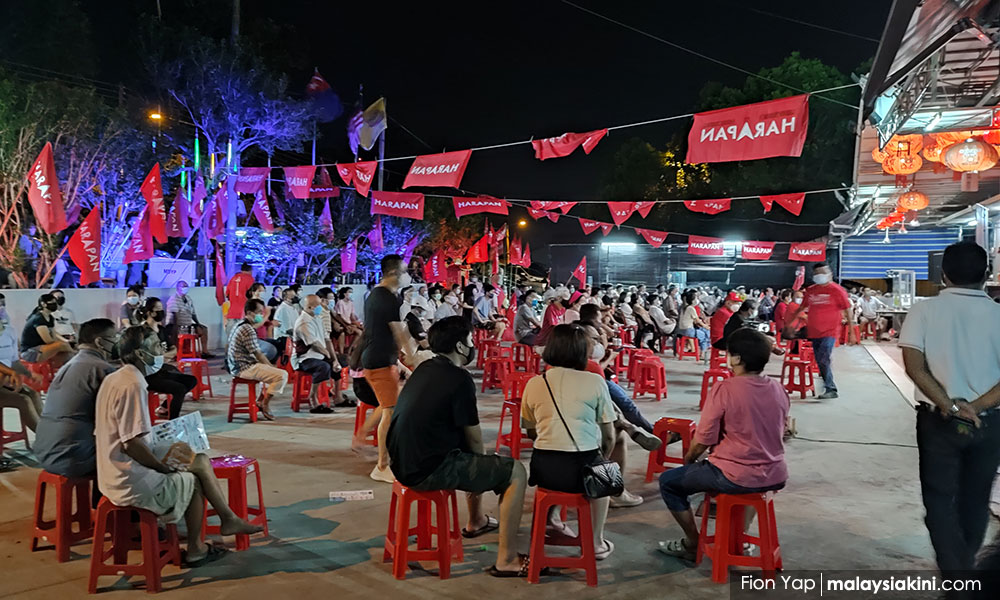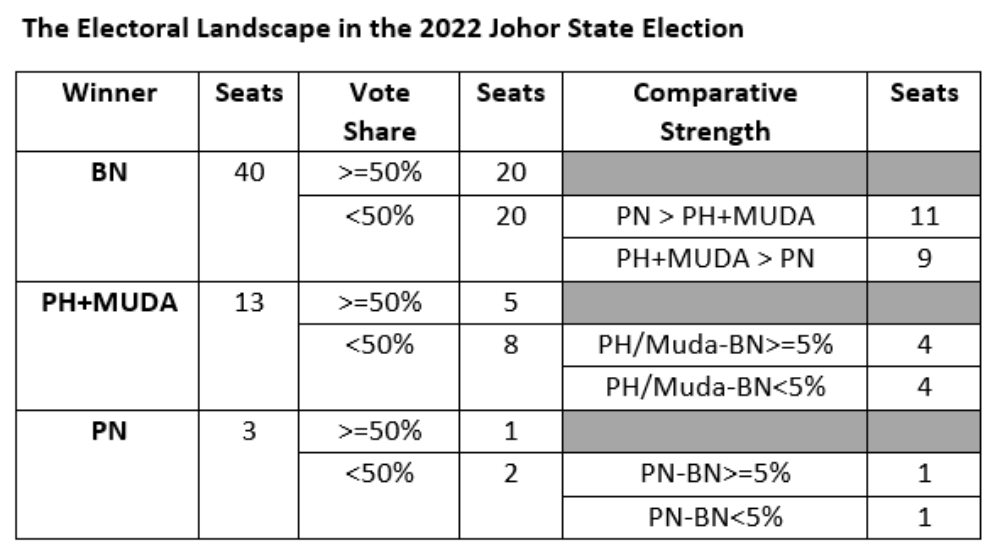What can be worse than denying one’s illness and rejecting treatment? Grabbing whatever medicine in desperation.
Immediately after the Johor polls, opposition supporters counted 20 seats that BN could have lost if the opposition parties had pooled their votes under one candidate.
In 19 constituencies, the combined votes of Perikatan Nasional, Pakatan Harapan and Muda beat BN.
Only in the 20th constituency, Parit Raja, PN-Bersatu and Muda would need Pejuang’s tiny 2.38 percent to beat BN’s 49.57 percent. All other parties - Warisan, PBM, PSM and Putra – are electorally irrelevant.
So, the diagnosis and prescription for the opposition are straightforward: they lost because they are divided, and they will win if they can unite again. Soon after, opposition politicians also talk about ‘big tent’.
Is it really a good idea for all opposition parties to kiss and make up, then put up one common candidate in each constituency? Definitely no.
Anything but Umno?
The idea that opposition parties can and must unite is much framed by the politics of the “two coalition system” since 1990. It assumes that opposition voters resist Umno more than other opposition parties. In short, Anything But Umno (ABU).
Driven by the ABU spirit, DAP and PAS embraced Umno top rebels from Tengku Razaleigh Hamzah (Save Malaysia 1.0) and Anwar Ibrahim, and under their leadership and intermediation, embraced each other. In 2017, DAP and PKR embraced Dr Mahathir Mohamad who sent their leaders to jail (Save Malaysia 2.0).

Those realignments were not easy but they happened nevertheless. And the last realignment even dislodged Umno’s 61-year rule. So, for some politicians and pundits, the opposition parties should just bury their grudges and stage another ABU realignment.
They perhaps forgot the two favourable conditions that made the previous ABU realignments work which no longer exists. First, Umno was weak and split. Second, the opposition was never elected, hence, an unknown worthy of trying.
Now, notwithstanding the split between Putrajaya and PWTC, Umno is more united than the opposition. All the contradictions between DAP and PAS and between PKR and Bersatu that torn apart both the Pakatan Rakyat and Harapan coalitions are not resolved.
So, why should the voters accept another round of realignment? ABU? Save Malaysia 3.0?
Voters who don’t follow parties
Behind the idea of the ABU big tent is that voters can be mobilised by anger against BN-Umno, which represents, beyond corruption, different evils to different communities: too Malay-centric and not Malay-centric enough, too Islamist and too secular.
More than that, these angry voters trust and follow their party leaders so much so they can also trust and support the parties they formerly hate, for the greater good. This assumption is empirically true, but it differs vastly across parties and communities.
The ability of PAS to tell its supporters to both “strengthen Muafakat Nasional” (with Umno) and “defend PN” (with Bersatu) without causing them cognitive dissonance is amazing, to say the least.
I remember a private conversation with a prominent economist in early 2018. He believed that DAP should make up with PAS to defeat Umno as Amanah was too weak. I told him that the Chinese would not accept PAS again after its return to hardline Islamisation. He however had great faith in DAP - the Chinese would just follow where DAP goes.
If the economist was right then, the DAP today definitely has lost its magical appeal on Chinese voters. Few have returned to MCA’s fold but many simply stayed out. In Johor, two-thirds of constituencies won by the DAP had lower-than-average turnout. Don’t attribute it to only the pandemic.

Increasingly, voters just don’t follow parties. This trend is not limited to - even if not as pronounced as others - Chinese Malaysians. Many other Malaysians, including Malays, are disillusioned. They express their distrust by not voting, unless and until they are seriously provoked by politicians whom they want to vote against.
In Johor, out of the 29 percent new voters, only seven percent were aged 18-20, the remaining 22 percent were products of automatic voter registration. If we can assume the turnout of pre-Undi18 voters in Johor was at 65 percent as in Malacca, then the overall 55 percent turnout rate means only 30 percent for the automatic voter registration and Undi18 new voters.
What if there was a ‘big tent’?
To best assess the merit of a ‘big tent’ including both Harapan-Muda and PN, we should look at all the constituencies.
Imagine this big tent with Anwar, Muhyiddin Yassin, Abdul Hadi Awang, Lim Guan Eng and Mohamad Sabu standing on the same stage urging voters to reject Najib Abdul Razak and Umno.
Out of the 20 constituencies that BN won because the opposition votes were split, how many Harapan+Muda voters would support PN (instead of supporting BN or simply abstaining) in the 11 constituencies that PN was the stronger opposition?
Likewise, how many PN supporters would support Harapan (instead of supporting BN or simply abstaining) in the remaining nine constituencies where Harapan+Muda was stronger?

Would the making up of Harapan+Muda and PN appear to be too opportunistic and unprincipled to cause at least five percent of the voters to stay at home? If so, Harapan+Muda would lose Bukit Batu, Tangkak, Jementah and Johor Jaya while PN would lose Bukit Kepong.
Fundamentally, is the likelihood of winning the 20 extra seats larger than the likelihood of losing the six seats? That in turn is a question: can the opposition still move voters with ABU and overlook their own contradictions?
Back to pre-ABU opposition politics
Perhaps the opposition parties should look back at the pre-1990 era. For three elections from 1978 to 1986, BN in Peninsular Malaysia was sandwiched by PAS on the Malay front and DAP on the non-Malay front.

Then, BN faced primarily PAS in Malay heartlands and DAP in Chinese constituencies. Multiethnic constituencies often saw multi-cornered fights with both PAS and DAP taking on BN, not out of enmity but as a tacit pact.
Like it or not, the peninsula politics has reverted to the 1980s, with PN as the expansion of PAS with another Umno splinter partner in Bersatu; and Harapan as the expanded partnership of DAP with three direct and indirect Umno splinters: PKR, Amanah and Muda.
It’s time to bury the two-coalition project and its ‘big tent’ vehicle. Instead of building another unsustainable big tent coalition, it is more practical for both Harapan-Muda and PN to consolidate their base and have selective multi-cornered fights in the 15th general election.
Instead of trying hard to whip up the ABU anger, they should develop appealing policy solutions to handle global crises hitting Malaysia; pandemic, climate change and war, both to appeal to the middle ground and prepare themselves for any post-election coalition. - Mkini
WONG CHIN HUAT is an Essex-trained political scientist working on political institutions and group conflicts. Mindful of humans' self-interest motivation while pursuing a better world, he is a principled opportunist.
The views expressed here are those of the author/contributor and do not necessarily represent the views of MMKtT.



No comments:
Post a Comment
Note: Only a member of this blog may post a comment.